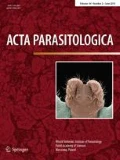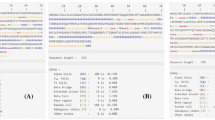Abstract
Introduction
Alveolar echinococcosis (AE) is a zoonotic disease caused by the parasitism of Echinococcus multilocularis larvae in the intermediate host or the final host. This study aims to identify and analyze the B-cell and T-cell (Th1, Th2 and Th17) epitopes of E. multilocularis antigen Emy162.
Methods
(1) The secondary structural characteristics of the Emy162 protein were predicted by bioinformatics software to further predict the potential T- and B-cell epitopes. (2) The dominant antigen epitopes were detected by ELISA through the reaction of patient serum with small B-cell antigen peptide and assessing the proliferation of splenic lymphocytes of mice immunized with Emy162. (3) The expression of cytokines in splenic lymphocytes of mice stimulated by small T-cell antigen peptides was detected by ELISA, ELISpot and flow cytometry to enable the identification of the T-cell epitopes.
Results
(1) The high-scored T-cell epitopes were located at positions E7-13, E36-41, E80-89, E87-96, E97-106 and E129-139, while B-cell epitopes were located at positions E7-13, E19-27, E28-36, E37-48, E78-83, E101-109, E112-121 and E129-139. (2) The three advanced antigen epitopes of Emy162 were E19-27, E112-121 and E129-139. (3) The four Th1 advanced antigen epitopes of Emy162 were E7-13, E36-41, E80-89 and E129-139. The three Th2 advanced antigen epitopes were E36-41, E87-96 and E97-106. The three Th17 advanced antigen epitopes were E36-41, E87-96 and E97-106.
Conclusion
(1) The Emy162 protein has advanced antigenicity and numerous potential epitopes. Six T-cell and eight B-cell dominant epitopes were revealed using bioinformatics methods. (2) There are three dominant B-cell epitopes, four dominant Th1 epitopes, three dominant Th2 epitopes, and three dominant Th17 epitopes in the Emy162 antigen.






Similar content being viewed by others
References
Cadavid Restrepo AM, Yang YR, McManus DP, Gray DJ, Barnes TS, Williams GM, Soares Magalhães RJ, Clements ACA (2018) Environmental risk factors and changing spatial patterns of human seropositivity for Echinococcus spp. in Xiji County, Ningxia Hui autonomous region, China. Parasit Vectors 11(1):159. https://doi.org/10.1186/s13071-018-2764-1
Nunnari G, Pinzone MR, Gruttadauria S, Celesia BM, Madeddu G, Malaguarnera G, Pavone P, Cappellani A, Cacopardo B (2012) Hepatic echinococcosis: clinical and therapeutic aspects. World J Gastroenterol 18(13):1448–1458. https://doi.org/10.3748/wjg.v18.i13.1448
Rebmann T, Zelicoff A (2012) Vaccination against influenza: role and limitations in pandemic intervention plans. Expert Rev Vaccines 11(8):1009–1019. https://doi.org/10.1586/erv.12.63
Wang F, Ye B (2016) Bioinformatics analysis and construction of phylogenetic tree of aquaporins from Echinococcus granulosus. Parasitol Res 115(9):3499–3511. https://doi.org/10.1007/s00436-016-5114-2
Zhang W, Wang S, Mcmanus DP (2014) Echinococcus granulosus\r, genomics: a new dawn for improved diagnosis, treatment, and control of echinococcosis. Parasite 21:66. https://doi.org/10.1051/parasite/2014066
Ma X, Zhou X, Zhu Y, Li Y, Wang H, Mamuti W, Li Y, Wen H, Ding J (2013) The prediction of T- and B-combined epitope and tertiary structure of the Eg95 antigen of Echinococcus granulosus. Exp Ther Med 6(3):657–662. https://doi.org/10.3892/etm.2013.1187
Saha S, Raghava GP (2010) Prediction of continuous B-cell epitopes in an antigen using recurrent neural network. Proteins 65(1):40–48. https://doi.org/10.1002/prot.21078
Li HB, Zhang JY, He YF, Chen L, Li B, Liu KY, Yang WC, Zhao Z, Zou QM, Wu C (2012) Systemic immunization with an epitope-based vaccine elicits a Th1-biased response and provides protection against Helicobacter pylori in mice. Vaccine 31:120–126. https://doi.org/10.1016/j.vaccine.2012.10.091
Mollica A, Stefanucci A, Costante R (2013) Strategies for developing tuberculosis vaccines: emerging approaches. Curr Drug Targets 14(9):938–951. https://doi.org/10.2174/1389450111314090002
Hazama S, Maeda K, Oka M (2012) Epitope peptide vaccine with oncoantigen for cancer and its biomarker. Nihon Rinsho 70(12):2189–2193
Ben-Yedidia T, Arnon R (2005) Towards an epitope-based human vaccine for influenza. Hum Vaccin 1(3):95–101. https://doi.org/10.4161/hv.1.3.1851
Kilkenny C, Browne WJ, Cuthill IC, Emerson M, Altman DG (2010) Improving bioscience research reporting: the ARRIVE guidelines for reporting animal research. PLoS Biol 8(6):e1000412. https://doi.org/10.1371/journal.pbio.1000412
Geourjon C, Deléage G (1995) SOPMA: significant improvements in protein secondary structure prediction by consensus prediction from multiple alignments. Comput Appl Biosci 11(6):681–684. https://doi.org/10.1093/bioinformatics/11.6.681
Cao LG, Ling H, Cai HL, Zhao FJ, Ouyang DM, Chen SF, Wu YM, Zeng TB (2015) Prediction and identification of B-cell epitopes of Treponema pallidumrepeat protein F. Chin J Zoonoses 31(10):919–922. https://doi.org/10.3969/j.issn.1002-2694.2015.10.005
Zeng SL, Ruan ZX, Tang JM, Liao LS, Sun J, Lin QY, Lv JQ, Ye YY, Zhu H, Li XQ, Wang HY, Yang JX, Hua QY (2015) Prediction, synthesis and establishment of indirect ELISA method for N protein B cell epitope of pestilence of ruminants virus. Progress Vet Med 36(8):40–44
Li WJ, Zou JQ, Han XX, Tian ZH, Liu J, Li HD (2015) Establishment of a method for purifying and culturing mouse spleen B lymphocyte. China Tissue Eng Res 19(2):207–212. https://doi.org/10.3969/j.issn.2095-4344.2015.02.009
Li Y, Liu X, Zhu Y, Zhou X, Cao C, Hu X, Ma H, Wen H, Ma X, Ding JB (2013) Bioinformatic prediction of epitopes in the Emy162 antigen of Echinococcus multilocularis. Exper Therapeut Med 6(2):335–340. https://doi.org/10.3892/etm.2013.1142
Thompson RC (2017) Biology and systematics of Echinococcus. Adv Parasitol 95:65–109. https://doi.org/10.1016/bs.apar.2016.07.001
Craig PS, Hegglin D, Lightowlers MW, Torgerson PR, Wang Q (2017) Chapter two—echinococcosis: control and prevention. Adv Parasitol 96:55–158. https://doi.org/10.1016/bs.apar.2016.09.002
Siles-Lucas M, Casulli A, Conraths FJ, Müller N (2017) Laboratory diagnosis of Echinococcus spp. in human patients and infected animals. Adv Parasitol 96:159–257. https://doi.org/10.1016/bs.apar.2016.09.003
Esmaelizad M, Ahmadian G, Aghaiypour K, Shamsara M, Paykari H, Tebianian M (2013) Induction of protective T-helper 1 immune responses against Echinococcus granulosus, in mice by a multi-T-cell epitope antigen based on five proteins. Mem Inst Oswaldo Cruz 108(4):408–413. https://doi.org/10.1590/S0074-0276108042013003
Zheng H, Zhang W, Zhang L, Zhang Z, Li J, Lu G, Zhu Y, Wang Y, Huang Y, Liu J, Kang H, Chen J, Wang L, Chen A, Yu S, Gao Z, Jin L, Gu W, Wang Z, Zhao L, Shi B, Wen H, Lin R, Jones MK, Brejova B, Vinar T, Zhao G, McManus DP, Chen Z, Zhou Y, Wang S (2013) The genome of the hydatid tapeworm Echinococcus granulosus. Nat Genet 45:1168–1175. https://doi.org/10.1038/ng.2757
Ranasinghe SL, Fischer K, Zhang W, Gobert GN, McManus DP (2015) Cloning and characterization of two potent Kunitz type protease inhibitors from Echinococcus granulosus. PLoS Negl Trop Dis 9(12):e0004268. https://doi.org/10.1371/journal.pntd.0004268
Wang J, Müller S, Lin R, Siffert M, Vuitton DA, Wen H, Gottstein B (2017) Depletion of FoxP3(+) Tregs improves control of larval Echinococcus multilocularis infection by promoting co-stimulation and Th1/17 immunity. Immun Inflamm Dis 5:435–447. https://doi.org/10.1002/iid3.181
Wang J, Vuitton DA, Muller N, Hemphill A, Spiliotis M, Blagosklonov O, Grandgirard D, Leib SL, Shalev I, Levy G, Lu X, Lin R, Wen H, Gottstein B (2015) Deletion of fibrinogen-like protein 2 (FGL-2), a novel CD4+ CD25+ Treg effector molecule, leads to improved control of Echinococcus multilocularis infection in mice. PLoS Negl Trop Dis 9(5):e0003755. https://doi.org/10.1371/journal.pntd.0003755
Gottstein B, Soboslay P, Ortona E, Wang J, Siracusano A, Vuitton D (2017) Immunology of alveolar and cystic echinococcosis (AE and CE). Adv Parasitol 96:1–54. https://doi.org/10.1016/bs.apar.2016.09.005
Lightowlers MW, Heath DD (2004) Immunity and vaccine control of Echinococcus granulosus infection in animal intermediate hosts. Parassitologia 46:27–31
Li ZF, Zhang S (2008) The progress and prospect of fundamental research of the spleen. J Xi'an Jiao Tong Univ (Med Sci Ed) 29(1):1–6
Ma XM, Ding JB (2013) Medical immunology. Tsinghua University Press, Beijing, pp 96–97
Wardah W, Khan MGM, Sharma A, Rashid MA (2019) Protein secondary structure prediction using neural networks and deep learning: a review. Comput Biol Chem 81:1–8. https://doi.org/10.1016/j.compbiolchem.2019.107093
Funding
This study was funding by Qinghai Provincial Science and Technology Department Project (2014-ZJ-719).
Author information
Authors and Affiliations
Corresponding author
Ethics declarations
Conflict of interest
The authors declare that there are no conflicts of interest.
Additional information
Publisher's Note
Springer Nature remains neutral with regard to jurisdictional claims in published maps and institutional affiliations.
Rights and permissions
About this article
Cite this article
Pang, MQ., Tang, F., Wang, HJ. et al. Prediction and Identification of Epitopes in the Emy162 Antigen of Echinococcus multilocularis. Acta Parasit. 65, 919–928 (2020). https://doi.org/10.2478/s11686-020-00231-0
Received:
Accepted:
Published:
Issue Date:
DOI: https://doi.org/10.2478/s11686-020-00231-0




